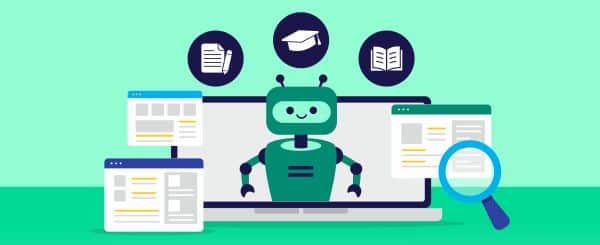Beyond Mass Personalization: Taking Personalization to a Higher Level
Fact: The number of U.S. schools that offer fully online Master of Business Administration (MBA) programs increased 85% — from 284 to 526 — between the 2016-17 and 2020-21 academic years, according to data from the Association to Advance Collegiate Schools of Business. Likewise, online programs for other in-demand degrees such as nursing and computer science degrees also are experiencing rapid growth. With so many options available to today’s prospective students, how can higher education marketers overcome a “sea of sameness” to shine attention on their institution and online degree programs and boost enrollment?
The answer is deceptively simple: Deliver a standout one-to-one personalized experience that engages prospective students and motivates them to apply and enroll in a program. But higher ed marketers know that’s much easier said than done. Budgetary, personnel, and technological limitations conspire to make delivering bespoke student experiences at scale a real challenge.
Traditional Recruitment Strategies Are Failing
While traditional strategies for attracting students like bulk mailings of glossy brochures, college fairs, tours, and phone calls still have a place in some higher ed recruitment strategies, they’re inadequate and ill-suited for recruiting the growing population of adult and nontraditional students — the target audience for online degree programs.
In higher ed today, students increasingly rely on digital channels to conduct college searches while institutions rely on them to communicate with students. Indeed, by the time a prospective student first interacts with a school’s website, they’ve often done considerable research and likely know a lot about the programs they’re considering. The challenge is to meet those students where they are by serving up personalized, relevant information that’s specific to that individual student in an engaging format via digital channels.
As the digital landscape continues to evolve, so must higher ed digital communication strategies. Embracing a strategy of constant innovation is the best path forward in today’s highly competitive and crowded higher ed market.
Higher Ed Marketing in the Digital Age
Like in other industries, higher ed is using digital strategies to connect with its target audience. Search engine optimization (SEO), social media marketing, pay-per-click advertising campaigns, and other online ad platforms all are tools in the higher ed digital marketing toolkit. These tools generate huge amounts of data that can become overwhelming, especially for smaller schools with limited marketing staff and resources.
Fortunately, customer relationship management (CRM) systems, which manage an institution’s relationships and interactions with potential students, can help. CRMs impose order on data flowing in from multiple digital marketing channels and act as repositories of information that higher ed marketers can use to their advantage.
Using CRM platforms, schools collect and analyze data, grouping prospects into specific audiences — a strategy known as segmentation. Then, personalized digital experiences can be created to match the audience groups to enable more effective targeting — a strategy known as mass personalization.
What Is Personalization?
Powered by a CRM or other type of student information or marketing automation platform, personalization — aka personalized marketing — is a marketing strategy in which institutions leverage data analysis and digital technology to deliver individualized messages and experiences to prospective students.
The degree of personalization can vary widely. For example, while inserting a prospective student’s name in a mass email technically is “personalization,” it’s not enough to engage students who are sophisticated consumers. The challenge for higher ed lies in making communications feel truly personalized to the student. And that requires a much more complicated approach to personalization.
What Is Mass Personalization?
With scalability in mind, higher ed has adopted the strategy of mass personalization — defined as the practice of creating personalized digital experiences for specific audience groups based on a set of criteria.
Mass personalization is more sophisticated than merely inserting an individual’s name into a mass email. For example, it might involve sending a link to a video interview with the school’s dean or an invitation to meet (online or by phone) with an enrollment advisor to all prospective students who — through their digital footprints or requests for information — have expressed interest in an online MBA or Master of Science in Nursing (MSN) program. However, this segmented audience approach is limited to separating students into buckets where all similar prospects are essentially treated the same and receive the same messaging.
Ranked on a scale of good, better, best, mass personalization certainly beats no personalization, but it still isn’t enough. While mass personalization enables scalability, the data shows it is failing when it comes to engaging prospective students.
The Problem With Mass Personalization
Not only is mass personalization a failing strategy — as evidenced by declining engagement measures like email opens, click throughs, and answered phone calls and text messages — but higher ed institutions that rely on it are missing opportunities to make their degree programs truly stand out by communicating their unique value proposition. Moreover, mass personalization doesn’t ensure that institutions are able to answer a prospective student’s most pressing questions or understand each individual prospective student’s motivations. These shortcomings point to a need for a more personal approach to personalization.
Mass Personalization vs. One-to-One Personalized Engagement
At Archer Education, we use the same data that’s collected and used to power the mass personalization or segmentation approach as the starting point for one-to-one personalization. Taking a one-to-one approach to personalization requires ongoing segmentation — data analysis on a granular level — and continued personalization of communication strategies and messages as recruiters learn more about the prospect.
These personalized conversations require a deeper level of understanding and tracking of the data collected, including what channel the lead came from, what digital features the student has interacted with, and the webpages they’ve viewed. For example, if the data shows that a student frequently visits pages related to financing a degree program, a communication directing them to a video on financial aid or an offer to connect them with a financial aid counselor may be just what they want to hear. Follow-up communications ask specific questions and provide tailored answers.
Prospective students appreciate the attention and care required to deliver relevant information specifically tailored to their individual needs, especially if that’s not what they’re getting from competing programs. Adult learners are often busy people with limited time to sort through mass communications looking for information that’s relevant to them. One-to-one personalization is a great way to make a school stand out in a crowded field.
Onward Powers One-to-One Personalization
The competitive advantage afforded by a higher ed recruitment strategy built on a one-to-one personalization model to maximize student engagement is obvious. But, as mentioned above, setting up the processes that support such a model are anything but simple.
While it’s challenging for schools to build their own data collection and multichannel communications platforms to enable effective one-to-one personalized communications, Archer’s Onward digital student engagement platform provides immediate student engagement and personalization at scale to get results.
A full-service, scalable platform, Onward caters to today’s digitally native students with a “digital-first” mindset and a high-touch engagement experience throughout the enrollment process — from lead nurturing to enrollment and beyond. It enables one-to-one personalized interactions driven by behavior-based triggers for a customized approach that meets each student’s individual needs. Unlike mass personalization strategies, Onward empowers outreach and follow-up that’s built on what prospective students have told us about themselves.
Instead of just urging students to apply or sending them back to the institution’s website, Onward sends prospects to a personalized destination — a digital experience tailored to each individual user with a unique url. The content is created based on exactly where they are in their enrollment journey — new lead, started application, submitted application, etc. — and provides relevant content to help them get answers to any questions, get in touch with an advisor, and take the next step forward on their journey. It’s like a personalized digital enrollment tour.
Onward helps higher ed institutions stand out, keeps prospective students engaged, and helps enrollment teams focus on those students who are a good fit for their program and are prepared to take the next step.
Creating Truly Personalized Student Experiences
Personalization continues to evolve in higher ed marketing and recruitment. In today’s dynamic market, keeping up requires constant innovation. At Archer Education, we help our partner institutions overcome enrollment challenges using tech-enabled, personalized enrollment marketing and management solutions. Learn more about Onward digital student experiences and how our proprietary platform can help your institution boost enrollment.



